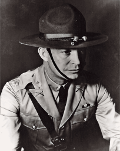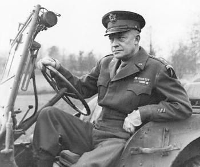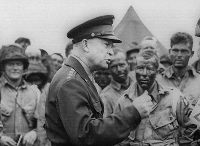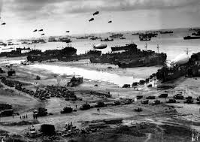Dwight D. Eisenhower: War Hero and President
Part 2: Rise to Prominence When the U.S. entered the war, in 1917, Eisenhower requested an assignment on the Western Front but instead was sent to Gettysburg, Penn., to help train soldiers in the newly developed tank corps. He spent the rest of the war in that capacity, displaying the organizational and leadership skills that would be the hallmarks of his future famous roles, and ended the war as a captain. His next assignment was Fort Meade, Md., to continue working with tanks. One of the experts he consulted on this topic was another famous American general, George Patton. In 1922, Eisenhower, then a major, began serving as executive officer to Brigadier General Fox Connor in the Panama Canal Zone. Connor helped Eisenhower get admitted to the Command and General Staff College at Fort Leavenworth, in Kansas. After completing his training and finishing first in his class, Eisenhower got a posting at Fort Benning, Ga., as a battalion commander, served a stint under the famous General John J. Pershing, and then took an assignment as executive officer to Assistant Secretary of War General George Mosely. 
The U.S. Army Chief of Staff, Douglas MacArthur, named Eisenhower to his staff, and Eisenhower in 1935 went with MacArthur to the Philippines, where he was promoted to lieutenant colonel. After an escalation of disagreements, the two eventually agreed to part ways and Eisenhower returned to Washington, D.C. He then was posted to California and Washington (state). Lieutenant General Walter Krueger, the commander of the 3rd Army, named Eisenhower his chief of staff in 1941; a promotion to brigadier general followed later that year. When the Japanese attack on Pearl Harbor precipitated the American entry into World War II, Eisenhower joined the General Staff and then became Chief of the War Plans Division. It wasn't long before he was appointed Assistant Chief of Staff to General George Marshall. 
Marshall appointed Eisenhower commander of the European Theater of Operations on June 24, 1942. Another posting followed, that of Supreme Allied Commander of the North African Theater of Operations. He was in charge of the Allied war efforts that resulted in the Axis forces' leaving Tunisia, in the process gaining command over the famed British General Bernard Montgomery. In 1943, Eisenhower directed the successful invasion of Sicily, by Montgomery and Patton, and then of Italy itself. President Franklin D. Roosevelt in 1944 confirmed Eisenhower as Supreme Allied Commander of the Allied Expeditionary Force, putting him in charge of the planned invasion of Germany's Fortress Europe and an assault on its vaunted Atlantic Wall, an extensive network of fortifications, barbed wire, and mines set up most notably by German Field Marshal Erwin Rommel. 

That invasion of France finally came, on D-Day, June 6, 1944. Eisenhower approved and monitored all aspects of Operation Overlord, as it was known. After extensive loss of life on both sides, Allied forces established a beachhead at Normandy and then punched through into the French interior. The Allied war effort survived the disappointment of Operation Market Garden, Montgomery's desperate attempt to combine airborne and ground assaults to liberate the Netherlands, and the dangerous desperation of the Battle of the Bulge. With generous assistance from both Montgomery and Patton, Allied troops rolled back German defenses and the prime Axis power surrendered, on May 8, 1945. Eisenhower, who had been promoted to General of the Army in December 1944, was named military governor of the U.S. Occupation Zone. Eisenhower attended the Potsdam Conference in July 1945 and was one of those who urged President Harry Truman not to use the atomic bomb against Japan, arguing that the last Axis power standing was on the verge of surrender anyway and, further, that using such a weapon would damage America's credibility in the international community. Next page > Famous in Two Realms > Page 1, 2, 3 |
|
Social Studies for Kids
copyright 2002–2026
David White




